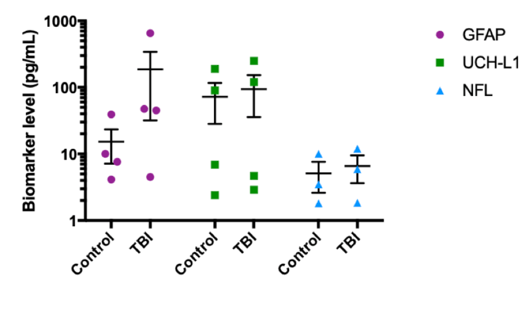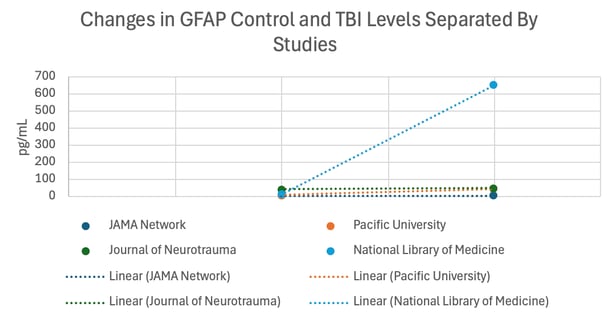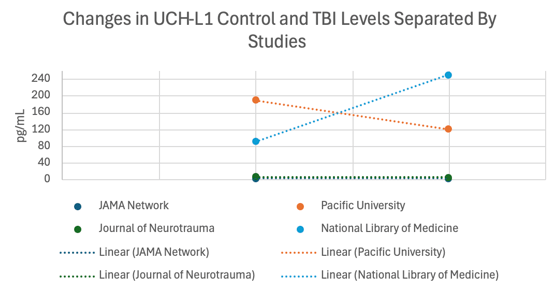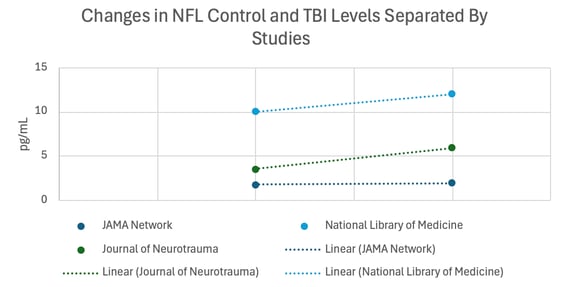Evaluating Biomarkers for Concussion Diagnosis: An Analysis of GFAP, UCH-L1, and NFL in Detection Accuracy
A research paper about detecting concussions using biomarkers (pending publishing)
Evaluating Biomarkers for Concussion Diagnosis: An Analysis of GFAP, UCH-L1, and NFL in Detection Accuracy
Author: Bhavya Muthu Mentor: Samantha Bottom-Tanzer; MD/PHD Tufts University
Abstract:
Traumatic brain injuries like concussions can have lasting impacts on athletes. Early diagnosis using objective biomarkers could improve outcomes. This study analyzed levels of three candidate biomarkers - GFAP, UCH-L1, and NFL - in athletes with diagnosed concussions. Multiple studies from the past 5 years were compiled showing GFAP had the largest average increase after injury, from 15.26 pg/mL to 186.72 pg/mL (171.46 pg/mL change). NFL also showed consistent slight elevations. However, UCH-L1 trends varied, with some studies showing increases and others decreases. On average, UCH-L1 only increased slightly. Of the three biomarkers analyzed, GFAP shows the most promise as a diagnostic indicator of concussion based on its large and consistent elevation across recent research. NFL may also be useful. More research is needed to clarify the utility of UCH-L1. Using a variety of biomarker combinations may also prove to show more promising results. Overall, this analysis sheds light on current candidate protein biomarkers for concussion screening and diagnosis, with GFAP emerging as the current front runner based on significance and consistency of elevation after injury. The results indicate that these biomarkers have tremendous potential to aid in rapid identification of concussions in athletes.
Introduction:
Traumatic brain injuries like concussions have profound and lasting effects on athletes. These include traumatic brain injuries which are often sustained during high-impact sports and can result in a range of physical, cognitive, and emotional consequences. Implementing proper diagnostic protocols is crucial as the inability to diagnose concussions accurately and promptly can lead to significant problems for athletes. Early diagnosis is important as it can prevent second-impact syndrome and long-term effects, and misdiagnosis. Identifying potential biomarkers could serve as objective indicators of concussion severity by utilizing blood or saliva samples to detect chemical biomarkers, including GFAP (Glial Fibrillary Acidic Protein), UCH-L1(ubiquitin C-terminal hydrolase L1), and NFL (neurofilament light chain). GFAP is a protein found in the central nervous system. They are expressed in astrocytes, which are a type of glial cell in the brain and spinal cord. Its main function is to provide structural support to astrocytes and help maintain the shape and integrity of these cells. In the past, GFAP has been considered a reliable and effective biomarker as concussions damage astrocytes. This releases GFAP into the bloodstream and elevates levels. UCH-L1 is an enzyme found in neurons and neuroendocrine cells. This enzyme plays a significant role in the regulation of cellular ubiquitin homeostasis and the removal of abnormal or misfolded proteins in neurons. It is primarily found in neurons and has been previously associated with Parkinson’s Disease and Alzehimers. Like GFAP, UCH-L1 is also released into the bloodstream or cerebrospinal fluid after a concussion. This can elevate its levels and provides researchers significant information regarding severity of a concussion. Lastly, NFL is a protein that is part of the cytoskeleton of neurons, particularly in the axons. If a concussion damages neurons, NFL is also a clear biomarker that is released into the cerebrospinal fluid and can indicate traumatic brain injury or a concussion. All three biomarkers can be found through blood samples and as of recent research, the most accurate and effective. This study aims to evaluate the effectiveness of the three biomarkers studied and if they are reliable for future use in health care settings.
Methods:
To collect the data, websites such as PubMed, Scientific Reports, and Web of Science
were used. The focus of this research was the differing levels of biomarkers in college athletes with concussions. When going about acquiring the data, the timeline included acute (immediately after injury) and a 7 days post-injury. This window allowed for accurate data of the biomarkers and showed the most promise with correlating results between papers. The 3 biomarkers were chosen due to the frequency that it had been previously studied and the progress made with these biomarkers thus far. Common keywords used to find articles included: concussions, biomarkers, traumatic brain injury, GFAP, UCH-L1, and NFL.
Results:
Figure 1: Out of all 3 Biomarkers GFAP levels increased the most from Control to TBI Figure 2: Changes in GFAP Control and TBI Levels separated by studies




Figure 3: Changes in UCH-L1 Control and Biomarker Levels separated by studies Figure 4: Changes in NFL Control and TBI Levels separated by studies




The study investigated the levels of GFAP, UCH-L1, and NFL in athletes diagnosed with concussions. Upon analysis of multiple studies conducted in the last 5 years, GFAP levels had the most significant increase from an average value of 15.26 pg/mL to 186.72 pg/mL. (Figure 1) This elevation persisted upon all studies and is marked by the average biomarker value change for GFAP (TBI) at 171.46 pg/mL. UCH-L1 levels, on the other hand, did not produce straightforward results. Although the average value of UCH-L1 levels increased from 72.33 pg/mL (control) to 94.4 pg/mL, when looking at individual studies, Pacific University and Journal of Neurotrauma produced results where the UCH-L1 levels decreased from 190 pg/mL to 120 pg/mL and from 6.9 pg/mL to 4.7 pg/mL respectively (Figure 3). Meanwhile, JAMA Network and National Library of Medicine produced results that correlated with the average levels (2.4 pg/mL to 2.9 pg/mL and 90 pg/mL to 250 pg/mL respectively). Lastly, NFL resulted in similar data to GFAP, in that the biomarker level increased, but it occurred in miniscule amounts. A promising factor in the NFL data is that the changes in pg/mL were more consistent than the changes found in GFAP or UCH-L1 levels shown by the slopes of the different studies (Figure 4).
Conclusion:
In conclusion, this analysis of recent studies on biomarker levels in athletes with concussions showed that GFAP had the most significant and consistent elevation out of the three biomarkers examined. GFAP levels increased over 10-fold on average after concussion. UCH-L1 levels were more variable between studies, with some showing increases and some showing decreases after concussion. On average UCH-L1 increased slightly, though individual study trends differed. NFL levels consistently showed slight but steady increases after concussion.
Of the three biomarkers, GFAP appears to be the most reliable indicator of concussion currently based on its large and persistent elevation across multiple recent studies. NFL may also have potential as a useful biomarker that shows consistent upward trends. More research is still needed on UCH-L1 as an indicator of concussion given the mismatch in trends between studies. Overall this analysis provides insight into the current utility of GFAP, UCH-L1, and NFL as quantitative biomarkers of traumatic brain injury and which biomarkers warrant further investigation or implementation. Standardizing research methods like utilizing psychological assessments and standard operating procedures may help resolve inconsistencies found for UCH-L1.
Some limitations that could have impacted results include the differences in participant controls used in each experiment, the severity/method of injury, the sex of the participant, and the method of measuring biomarker levels. Some studies used preseason controls while others used acute controls. Differences in baseline biomarker levels between athlete and non-athlete populations could impact the relative magnitude of changes seen post-concussion. Secondly, the severity and mechanisms of the traumatic brain injuries likely varied significantly between studies, which could alter expected biomarker responses. Differentiating between contact and non-contact sports could also reveal clearer patterns not identifiable in the current data. Lastly, the sex of the participants could stimulate changes not highlighted in the data. For example, if certain biomarkers are more variable or responsive in one sex, and only that sex was studied, the data could be slightly skewed.
The elevations in GFAP, NFL, and UCH-L1 levels found across recent studies indicate these biomarkers have significant potential for aiding concussion screening and diagnosis. However, additional steps are needed to facilitate real-world implementation. Standardized detection protocols and reference ranges for GFAP, NFL, and UCH-L1 should be established to enable consistent interpretation of levels clinically. First, more validation studies with consistent results could be used. Moreover, combining these biomarkers with patient symptom reporting, cognitive testing, and imaging will maximize the impact of GFAP, NFL, and UCH-L1 as automated diagnostic indicators of traumatic brain injury. The results thus far indicate these biomarkers have tremendous potential to aid in rapid and accurate identification of concussions in athletes once additional research and development moves them towards clinical implementation and may yield optimal diagnostic and prognostic performance.